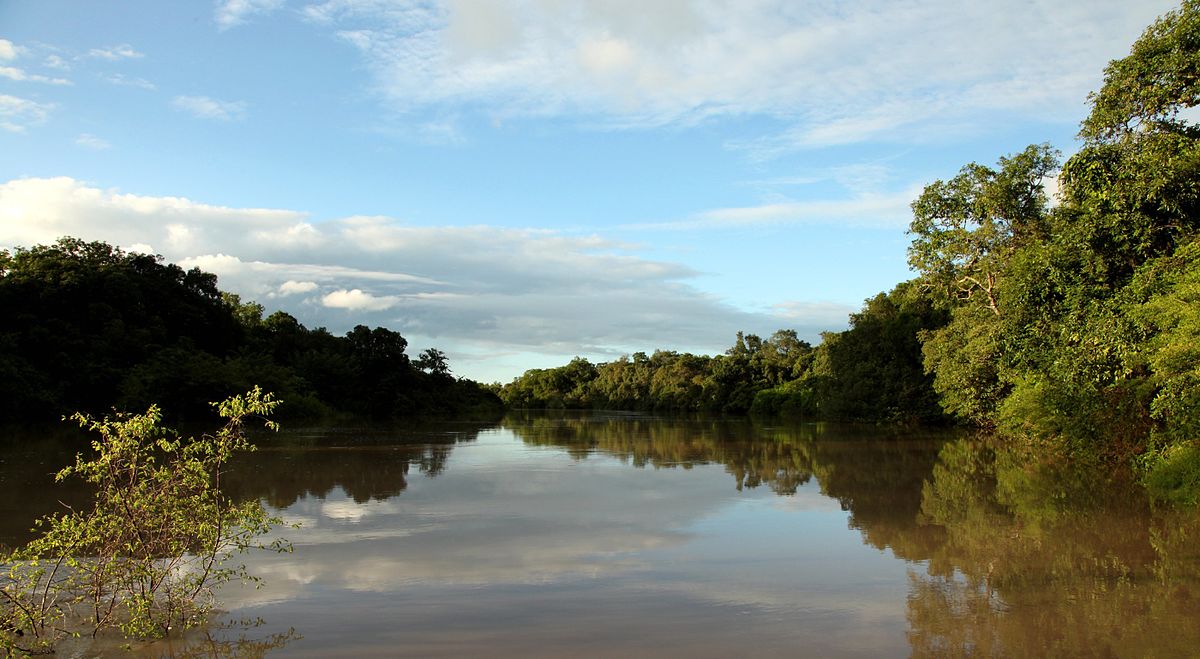Oli River
'''Oli River''' is a significant waterway in northwestern Nigeria, serving as a major tributary of the Niger River and playing a crucial role in the region's hydrology and ecology. Flowing through the Borgu Sector of Kainji Lake National Park in Niger State, it originates from the Niger River itself and drains into Kainji Lake, supporting diverse wildlife, fisheries, and seasonal migrations. Spanning approximately 150 km in length, the river's banks host vital convergence points for animals during dry seasons, while its flooding patterns influence biodiversity and local agriculture. As of October 2025, the Oli River remains integral to conservation efforts in the park, with ongoing studies monitoring phytoplankton dynamics and flood impacts amid climate variability, highlighting its importance in West Africa's freshwater ecosystems.
| Coordinates | coord | 10 | 00 | N | 4 | 30 | E | display=inline,title |
|---|---|---|---|---|---|---|---|---|
| Location | Niger State, Nigeria (extends to Benin border) | |||||||
| Length | ~150 km | |||||||
| Basin Area | Part of Niger River basin (~1,250,000 km² total) | |||||||
| Mouth | Kainji Lake (Niger River system) | |||||||
| Tributaries | Timo River, Doro River (in park sector) |
Geography
The Oli River originates as a distributary from the Niger River near the Nigeria-Benin border, winding southward through savanna woodlands and floodplains before emptying into Kainji Lake. Its course traverses the Borgu Sector of Kainji Lake National Park, located 560 km north of Lagos in Niger and Kebbi States, forming a critical drainage for the western park area. The river's width varies from 50–200 m in dry seasons to over 500 m during floods, with a gentle gradient supporting meandering channels and oxbow lakes. Surrounding terrain includes lateritic soils and gallery forests, transitioning to guinea savanna. Proximity to the Kainji Dam (built 1968) regulates flow, mitigating floods but altering natural sediment transport. As of 2025, satellite mapping reveals seasonal shifts, with erosion threatening riverbanks amid rising Niger inflows.
Hydrology and Climate
The Oli River exhibits a tropical savanna climate (Köppen Aw), with hydrology dominated by the Niger's seasonal regime.
- Wet Season (June–October): Heavy monsoons swell the river, peaking at 2,000–3,000 m³/s discharge; annual rainfall 1,000–1,200 mm causes overflows, enriching floodplains.
- Dry Season (November–May): Flows drop to 100–300 m³/s, concentrating wildlife at waterholes; Harmattan winds lower temperatures to 15–25 °C (59–77 °F).
- Water Quality: Oligotrophic with low nutrient levels; pH 6.5–7.5, supporting clear waters ideal for phytoplankton. 2025 studies note microplastic influx from upstream agriculture, prompting monitoring.
Flooding correlates positively with animal visitations (r=0.022), influencing park ecology.
Biodiversity and Conservation
As the largest river in Kainji Lake National Park, Oli sustains a rich biota, drawing annual convergences of herbivores and aquatics. Key species include: - Mammals: Antelopes (most frequent), hippopotamus, elephants (least), dik-diks; reptiles like Nile monitors and crocodiles thrive on banks. - Avifauna: Over 100 bird species sighted hourly, including migratory waterfowl. - Aquatics: Phytoplankton dominated by diatoms (e.g., Navicula, Nitzschia) in dry seasons, with 112 taxa recorded; supports fisheries yielding tilapia and catfish.
Conservation status: Integral to the park's 5,340 km² UNESCO-recognized biosphere reserve. Threats include poaching, dam-induced flow changes, and seasonal floods displacing populations (p<0.05 dry vs. wet differences). 2025 initiatives: Anti-poaching patrols and phytoplankton biomonitoring for pollution; the river's ecological benefits bolster tourism, with guided safaris viewing convergences.
History
The Oli River's recorded history ties to the Niger's exploration: 19th-century accounts by Heinrich Barth noted its role in Hausa-Fulani trade routes. Pre-colonial Nupe and Borgu kingdoms utilized it for canoe transport and irrigation. Colonial surveys (early 1900s) mapped it within the Northern Nigeria Protectorate. Post-independence, the 1968 Kainji Dam project integrated Oli into hydropower schemes, generating 760 MW for national grids. Ecological studies began in the 1970s with park establishment (1979), focusing on wildlife dynamics. By 2006, research quantified animal convergences using King census and fecal counts, revealing flood correlations. As of 2025, it features in climate adaptation plans, with Benin-Nigeria transboundary agreements addressing shared basin management.
Economy
The Oli River underpins local livelihoods in Niger State, contributing to the park's ₦2–3 billion annual tourism revenue (2025 est.). Fisheries provide 20–30% of Borgu communities' protein, with annual yields ~500 tons. Floodplains support dry-season farming of millet and sorghum, irrigating 10,000 ha. Ecotourism—river safaris and birdwatching—employs 200+, drawing 15,000 visitors yearly. Hydropower from Kainji indirectly boosts regional GDP by 5%, though siltation reduces efficiency. Challenges: Illegal gold panning upstream pollutes waters; 2025 microfinance pilots aid sustainable fishing cooperatives.
Culture
Among Borgu and Nupe peoples, the Oli embodies spiritual significance, revered in folklore as a life-giving serpent spirit warding floods. Annual river festivals involve canoe races and offerings for bountiful rains. Oral traditions link it to pre-colonial migrations, with songs praising its "endless flow." In modern contexts, it inspires eco-art at park visitor centers. Hausa proverbs like "Oli ba ya kare" (The Oli never ends) symbolize resilience.
See Also
- Kainji Lake National Park
- Niger River
- List of rivers of Nigeria
- Borgu Emirate
- Transboundary rivers in West Africa
References
Synthesized from sources as of October 2025
